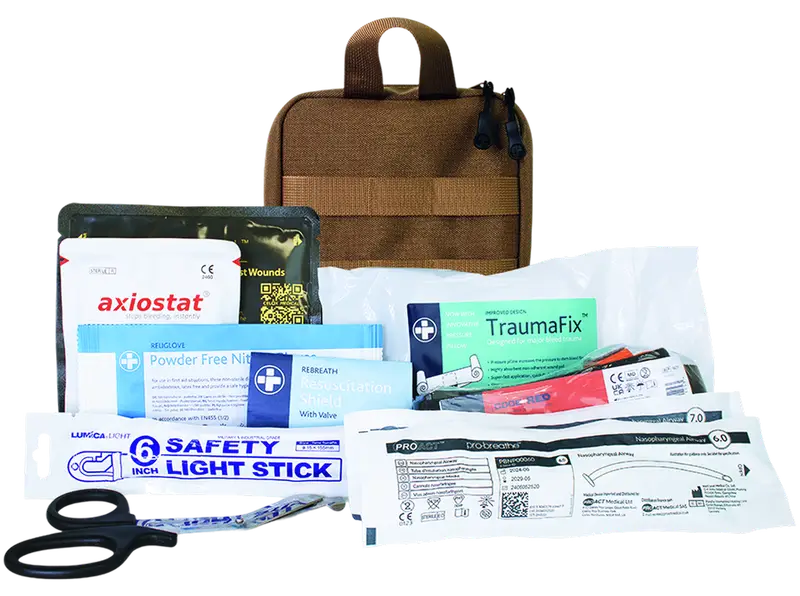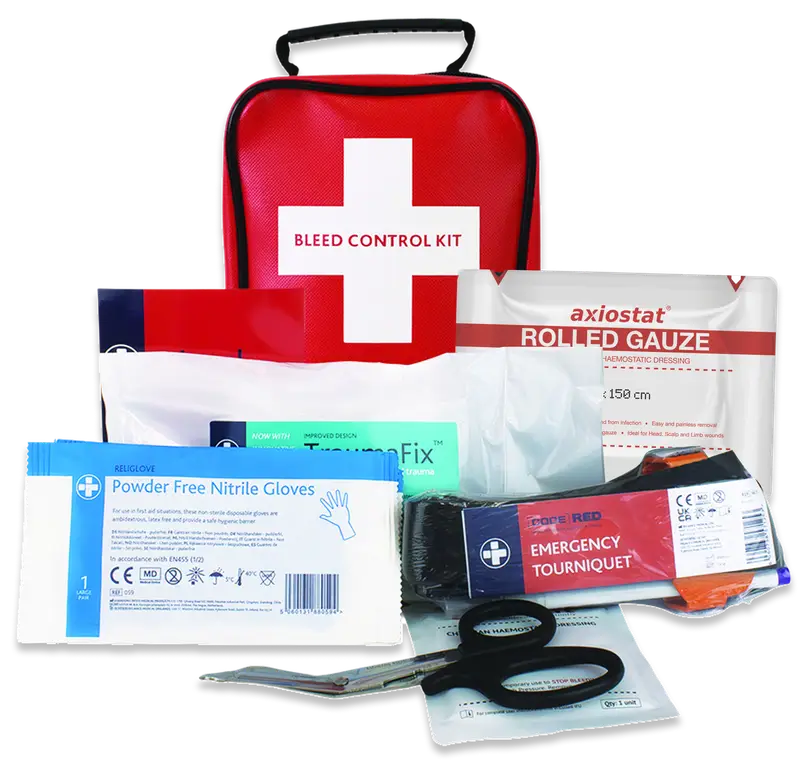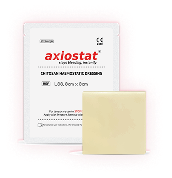Sometimes, professional help might take time to arrive. In those few minutes, you or someone nearby may need to act. A bleed control kit gives you the tools to stop the bleeding and keep the person alive until help arrives.
Because of this, many public places like schools, malls, and airports are now keeping bleed control kits in visible, easy-to-access spots.

Let’s go step by step and look at what’s in a bleed control kit. Most kits come with basic items that help stop bleeding fast. Some may have extras, depending on the type of place or user.
1. Axiostat Hemostatic Gauze
This is one of the most important things inside. It’s not just regular gauze. It’s made with a special material called chitosan that helps your blood clot quickly.
Axiostat Hemostatic Gauze is trusted by doctors, paramedics, and even the military. It works well on deep wounds and doesn’t need your body to start clotting—it helps the process happen faster.
2. Tourniquet
This tool is used when the bleeding is too heavy and from an arm or leg. You place it above the wound and tighten it to stop the blood flow. It’s especially helpful for serious injuries.
3. Gloves
Gloves protect both you and the person you’re helping. You don’t want to touch blood with bare hands. Most kits include strong nitrile gloves.
4. Airway Tools (Optional)
Some advanced kits may also have tools to keep a person’s airway open. These are more common in kits used by trained professionals.
5. Instruction Card
Emergencies are stressful. A simple step-by-step card inside the kit can help guide you, even if you’re nervous.
6. Compact Case
Everything comes in a small, sturdy case that’s easy to carry and strong enough to survive rough use—like in factories, cars, or outdoor settings.
Now that you know what’s in a bleed control kit, let’s go over how to use bleed control kit items the right way. Here’s a simple 6-step process anyone can follow.
Step 1: Stay Safe First
Before helping, check your surroundings. Don’t put yourself in danger. Wear gloves before touching any blood.
Step 2: Find the Bleeding Spot
Look for spurting blood, a large pool of blood, or clothes soaked in blood. These are signs of serious bleeding.
Step 3: Use the Axiostat Gauze
Open the Axiostat Hemostatic Gauze and gently pack it deep into the wound. Press down firmly for at least 3 minutes. This will help the bleeding slow down or stop.
Step 4: Use a Tourniquet (If Needed)
If the bleeding is from a limb and still won’t stop, use a tourniquet. Wrap it a few inches above the wound and tighten it until the bleeding stops. Don’t forget to note the time you applied it.
Step 5: Watch the Person Closely
Look for signs of shock like pale skin, weak pulse, or fast breathing. Keep the person calm and warm. Wait with them until help arrives.
A bleed control kit is only helpful if it’s nearby when something happens. Here are the best places to keep one:
Not all gauze works the same. Axiostat Hemostatic Gauze is known for a few clear advantages:
Kits that include Axiostat are considered high-quality and more reliable in serious emergencies.
Knowing what’s in a bleed control kit and how to use a bleed control kit can turn you into someone’s hero in a crisis. These kits are not just for professionals—they are for anyone who wants to be ready to save a life.
The time to prepare is now. Don’t wait for an emergency to realize how valuable these kits are. Keep one in your car, your home, or your workplace. And when choosing one, look for Axiostat Hemostatic Gauze—because every second matters, and the right tools can mean the difference between life and death.
1. What’s in a bleed control kit?
A typical bleed control kit includes:
2. How to use bleed control kit on a severe wound?
Use hemostatic gauze to pack the wound, apply firm pressure for 3+ minutes, then cover with a trauma dressing. For limb injuries with massive bleeding, apply a tourniquet above the wound.
3. Who should have access to a bleed control kit?
Everyone should know where bleed control kits are located:
4. Can I use a bleed control kit without medical training?
Yes! Bleed control kits are designed for use by both trained professionals and the general public. Many kits include clear, easy-to-follow instructions for use.
Axiostat® Vascular Patch
Axiostat® Vascular Patch
V35
V55
3.5cm x 3.5cm
5cm x 5cm
Box of 15
Box of 10

Axiostat® Z-Fold Gauze – 7.6cm x 300cm
Foxseal Occlusive Chest Seal (Contains 2 Chest Seals)
TraumaFix Dressing Sterile Including Pressure Pad 10cm x 18cm
CODE RED Emergency Tourniquet
Rebreath Mouth to Mouth Resuscitation Device with Valve
Religlove Nitrile Examination Gloves Large (Pair)
6″ Military Grade High Intensity Cyalume Lightstick White
PRO-Breathe Nasopharyngeal Airway, Size 6
PRO-Breathe Nasopharyngeal Airway, Size 7
Universal shears large 7.6″
1
1
1
1
1
1
1
1
1
1

Axiostat® Rolled Gauze – 7.6cm x 150cm
Religlove – Nitrile Examination Gloves – Large – Pair
Universal shears large 7.6″
TraumaFix Dressing Sterile Including Pressure Pad
CODE RED Emergency Tourniquet
Foxseal Occlusive Chest Seal
Bleed Control Guidance Leaflet
1
2
1
1
1
1
1
Axiostat® Rolled Gauze
Axiostat® Z-Fold
Axiostat® Z-Fold
Axiostat® Patch
Axiostat® Patch
Axiostat® 4-Ply Gauze
Axiostat® Single Ply Gauze
Axiostat® Rolled Gauze
6510-72-057-0462
6510-72-057-0460
6510-72-057-2313
6510-72-057-0464
–
6510-72-057-2350
6510-72-057-0461
–
L150
MIL300
MIL150
L88 / MIL88
M85
L2020
L1010 / MIL1010
L100
7.6cm x 150cm
7.6cm x 300cm
7.6cm x 150cm
8cm x 8cm
8cm x 5cm
20cm x 20cm
10cm x 10cm
7.6cm x 100cm
Individual
Individual
Individual
Box of 10
Box of 10
Box of 10
Box of 10
Individual


For Femoral and Radial Access Closures


For Femoral and Radial Access Closures